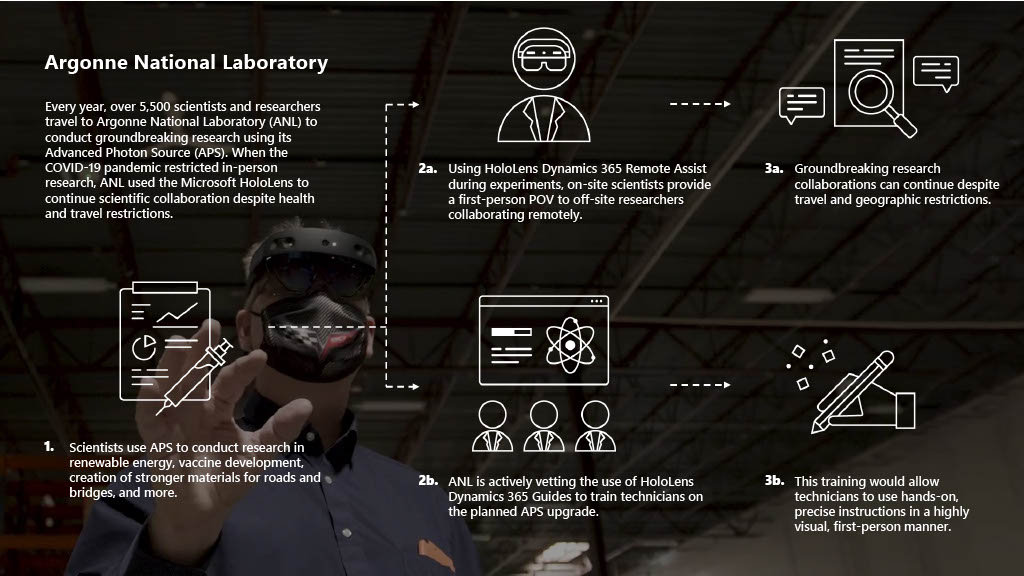Argonne National Laboratory reimagines scientific collaboration during a global pandemic
Downloads
Resources
Products
Argonne National Laboratory (ANL) is a U.S. Department of Energy (DOE) multidisciplinary science and research facility, where talented researchers work together to answer the most challenging scientific questions facing humanity.
During a typical year, more than 5,500 researchers visit ANL’s Advanced Photon Source (APS), a DOE Office of Science user facility, to conduct groundbreaking research. The APS is an X-ray storage ring facility whose ultrabright X-ray beams illuminate the structure and chemistry of materials at the molecular and atomic levels. It has played a crucial role in the development of renewable energy technologies, electric vehicle batteries, and vaccines.

Continuing collaboration
Like schools, restaurants, salons, and offices everywhere, the APS had to limit the number of people allowed onsite when the COVID-19 pandemic took hold. “My lab is usually very busy. I might have up to five groups working at the same time. But when COVID-19 hit, we suddenly stopped,” says Kamila Wiaderek, beamline scientist and electrochemist at the APS.
While some professions can easily slip into the work-from-home lifestyle, scientific research is not one of them. It’s extremely collaborative and hands-on, often relying on massive instruments that cannot be relocated outside the lab.
“Initially, everybody was thinking maybe this is going to take a month or two. But sure enough, two months in, we all realized this is not the end. We have to figure out ways to do it differently.”
With the once-bustling lab slowed down, APS scientists needed a way to continue their collaborative research in the age of social distancing and remote work.
Scientific collaboration—from the lab to the living room “We started looking for solutions on how to bring people to the beamlines without actually traveling and meeting with us. When I learned about the HoloLens, I was interested in the possibilities,” says Olaf Borkiewicz, lead beamline scientist at experiment station 11-ID-B at the APS.
HoloLens is a hands-free, mixed reality headset providing a high-resolution display of surroundings. APS scientists realized that on-site researchers can wear a HoloLens while conducting experiments and essentially give off-site collaborators, who are watching remotely, the experience of a first-person POV. Because it’s a headset, scientists can collect samples, run diagnostics, and use machinery with both hands, totally unencumbered.
“It really frees my hands so I can show what I'm doing, especially for the collaborators that I'm preparing samples for their experiments. They have this record that shows exactly what I did. The picture quality allows is to do what needs to be done. You don't see your own hands. It's just gloves, so it's almost like you did it,” says Wiaderek.
Its high-quality picture gives collaborators the experience of being in the room, while at home, allowing for crucial research to continue despite travel or geographic restrictions.
A bright future
Technician training is another area where the HoloLens may assist the APS. The laboratory is upgrading APS’ storage ring—which will make its X-ray beams about 500 times brighter—and is considering using the HoloLens to train technicians to help build components for the upgrade. Using Dynamics 365 Guides with HoloLens, technicians would receive hands-free and precise instructions for the training that are visually tethered to their environment. APS leaders hope it may make training faster and more intuitive by using highly visual instruction rather than stacks of complicated paper manuals.
“Instead of having paper copies and subject matter experts that have to follow along with the people, we'd use the HoloLens to guide new technicians through the process of assembling things. There are many areas that the HoloLens can be used we haven't even approached yet.”
Recommended Videos
NOAA preserves Alaskan marine life with the Cloud and AI
Explore how NOAA uses Cloud and AI to find and track endangered marine species at risk due to climate change and habitat degradation.
Explore our Technology Explainer Video page for overview videos explaining the emerging technology of today, including AI, Machine Learning, and more.
